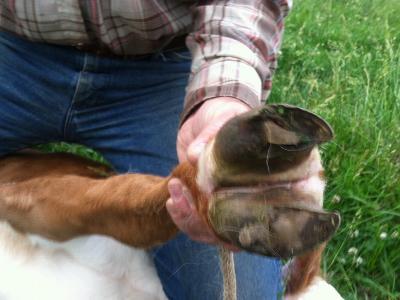Diseases of Cattle: Footrot

Fusobacterium necrophorum and Bacteroides melaninogenicus are the predominant bacteria isolated from footrot. Footrot occurs in cattle of all ages, but it is most common in adults. The disease is seen year-round, but there is increased incidence in the wet summer and fall months.
Bacteria gain entrance through lesions on the lower part of the foot; the bacteria do not penetrate normal skin. Anything that can damage the skin between the claws should be considered as predisposing to the disease. Wet manure and mud can soften the skin between the claws and permit infection. Dried or frozen mud, stones, and stubble can bruise the tissues sufficiently to lower their resistance to disease.
Lameness appears suddenly; usually only one foot is affected. An animal will put little weight on the affected leg, but will place weight on the limb while walking or running. A moderate fever (103º-104º F.) may accompany the early signs. The typical early lesion is a break in the skin between the claws. Pus may be present, but not in large amounts. Edges of the break are covered with necrotic material, and the lesion has a characteristic foul odor. The foot is swollen and the animal is in acute pain.
Spontaneous recovery may occur, but if the animal is not treated, the lameness may persist for several weeks. Penicillin, tetracyclines, sodium sulfadimidine, sulfabromomethazine, and other antibacterial agents are used for systemic therapy. Daily treatment begun immediately after onset of lameness usually will give excellent recovery in two to four days. Treated animals should be maintained on a dry surface until recovered. Recent research has shown that dietary zinc supplementation is effective in treating and preventing footrot in cattle. Feeding chlortetracycline (CTC) at the rate of 0.5 mg / lb. body weight daily may also help prevent foot rot. Many mineral mixes and commercial supplements are formulated to contain the correct amount of chlortetracycline (CTC).
Có thể bạn quan tâm
 Crude protein levels low in 2016 silage crops
Crude protein levels low in 2016 silage crops Find out how to create the best quality silage. In the first and second cuts, average crude protein levels are 14.1 and 14.2 percent, respectively.
 Mycotoxins in corn silage threaten ruminant performance
Mycotoxins in corn silage threaten ruminant performance 2015 corn harvest found to have moderate to high risk levels of multiple toxins, calves especially susceptible
 Diseases of Cattle: Foot-and-Mouth
Diseases of Cattle: Foot-and-Mouth Foot-and-Mouth Disease is a severe, highly communicable disease of cattle, pigs, sheep, goats and deer. It is caused by one of the smallest disease producing